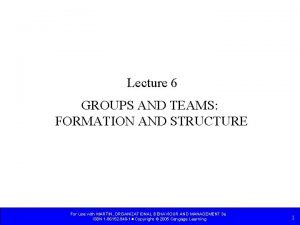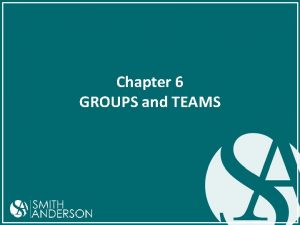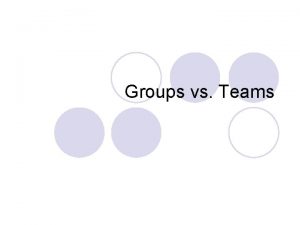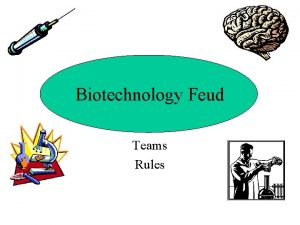Groups Teams Introduction Groups and teams are a






- Slides: 6

Groups & Teams Introduction Groups and teams are a pinnacle for organizational management. There are both commonly seeking a goal, but there are differences between groups and teams. A group is a collection of individuals who coordinate their individual efforts while a team is a group of people who share a common team purpose and a number of challenging goals. Being able to effectively use groups and teams can improve the productivity of a business. Objective To understand my role in effectively developing groups or teams based on business dynamics and needs in a global world

Groups & Teams Powering Up Teams 1 Understanding the roles within a team and what makes them effective is the underpinning of “Powering Up Teams. ” Four elements are described for team empowerment: Ø Potency: confidence, a can-do attitude, and expertise. Ø Meaningfulness: commitment and purpose. Ø Autonomy: freedom, discretion and control of projects and tasks. Ø Impact: observe completed results. Along with these four elements are four defined roles that help multiple the effectiveness. Ø Leader’s Behaviors: Entrusts members, ensures accountability, makes recommendations and suggestions, encourages team members, upholds high expectations and displays trust. Ø Production/Service’s (Team’s) Responsibilities: Sets priorities and standards, holds others accountable, assigns tasks appropriately to members, instills initiative culture, and understands the overall fluidity required for a finished product; not just their part. Ø Human Resource Management System: HR offers team-based compensation based on performance, offers cross-training, staffs appropriately, and facilitates peer evaluations. Ø Social Structure: Receives support from ancillary teams or departments, has access to resources, and has the latitude to create its own rules and policies. By implementing these four roles, teams will receive the empowerment they need to succeed. 1 Gupta, 2001 Anil, and Vijay Govindarajan. "Building an Effective Global Business Team. " MIT Sloan Management Review 42. 4 (2001): n. pag. 15 July

Groups & Teams Building an Effective Global Business Team 1 Approximately one-third of global teams rated their performance as "unsuccessful" and only 18% were rated as "highly performing". For failing teams, two chief pitfalls were stated as reasons for innate failure: the inability to cultivate trust and hindrances in communication. Teams that were successful diminished the two common pitfalls and also succeeded in providing the following formula: Key points for success were overcoming communication barriers, creating a culture of trust, agreeing on norms of behavior, adopting data-driven decisions, developing alternatives to enrich debate, and rotating meeting locations (if possible). 1 Kirkman, Bradley L. ; Rosen, Benson Organizational Dynamics, Vol 28(3), 2000, 48 -66.

Note to Markham: This slide is written from an administrator’s perspective as I will use it with my employees immediately. Groups & Teams Exercise The Situation Your organization has just assigned you to a newly formed task team which is to take over a secret Project presently being handled by Research and Development. Your entire team has been assigned responsibility and authority to first design a plan for managing the Project and then, after top management has reviewed and accepted your plans, carry out the Project. None of you have been told anything about the Project, so far, other than it is expected to grow to sizeable proportions requiring additional people. The Task Despite the lack of information regarding the Project, your team must now design a preliminary plan for managing the Project. On the next page is a list of 20 Management Activities (A through T) arranged in random order. Your task is to rank order these activities according to the sequence you would follow in planning, organizing, implementing and controlling the Project. This sequence will be reviewed by top management before you are given the go-ahead to begin work on the Project. Step 1: Since you have a few minutes before your team meets for the first time, go over the list of activities on the next page and, without discussing it with anyone, rank order the management activities according to the sequence you think should be followed in managing the Project. Start with "1, " the first activity through "20, " the last activity. If, while working through this, you change your mind, cross out (do not erase) your old response. Once the teamwork begins, don't change your individual ranking. Step 2: Now, as a team, agree to the sequence of activities that should be followed.

Note to Markham: This slide is written from an administrator’s perspective as I will use it with my employees immediately. Groups & Teams Exercise A. Find qualified people to fill positions. Suggested Ranking 12 B. Measure progress' toward and/or deviation from the Project's goals. 17 C. Identify & analyze the various job tasks necessary to implement the Project. 8 D. Develop strategies (priorities, sequence, timing of major steps). 6 E. Develop possible alternative courses of action. 3 F. Deliver appropriate consequences for individual performance. 20 G. Assign responsibility/accountability/authority. H. Set Project objectives (desired results). 15 2 I. Train and develop personnel for new responsibilities/authority. 13 J. Gather and analyze the facts of the current project situation. 1 K. Establish qualifications for new positions. L. Take corrective action on Project plans. M. Coordinate day-to-day activities. 10 19 16 N. Determine the allocation of resources (including budget, facilities, etc. ) 11 O. Measure individual performance against performance objectives and standards. 18 P. Identify the negative consequences of each course of action 4 Q. Develop individual performance objectives which are mutually agreeable to the individual and his/her manager. 14 R. Define scope of relationships, responsibilities and authority of new positions. 9 S. Decide on a basic course of action. 5 T. Determine when and how overall progress is to be measured. 7 Management Activities Individual Ranking Team Ranking

Note to Markham: This slide is written from an administrator’s perspective as I will use it with my employees immediately. Groups & Teams Exercise Now calculate the difference between your individual score and the suggested ranking and do the same for the team’s. What do you notice about your totals? A. Find qualified people to fill positions. Suggested Ranking 12 B. Measure progress' toward and/or deviation from the Project's goals. 17 C. Identify & analyze the various job tasks necessary to implement the Project. 8 D. Develop strategies (priorities, sequence, timing of major steps). 6 E. Develop possible alternative courses of action. F. Deliver appropriate consequences for individual performance. G. Assign responsibility/accountability/authority. H. Set Project objectives (desired results). 3 20 15 2 I. Train and develop personnel for new responsibilities/authority. 13 J. Gather and analyze the facts of the current project situation. K. Establish qualifications for new positions. L. Take corrective action on Project plans. M. Coordinate day-to-day activities. 1 10 19 16 N. Determine the allocation of resources (including budget, facilities, etc. ) 11 O. Measure individual performance against performance objectives and standards. 18 P. Identify the negative consequences of each course of action 4 Q. Develop individual performance objectives which are mutually agreeable to the individual and his/her manager. 14 R. Define scope of relationships, responsibilities and authority of new positions. S. Decide on a basic course of action. T. Determine when and how overall progress is to be measured. 9 5 7 Management Activities Individual Ranking Team Ranking Difference (Individual) (Team)











